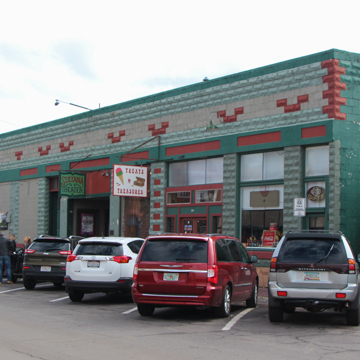You are here
Sultana Building
Developed between 1912 and 1915 by local merchant Ben Sweetwood, the Sultana Building functioned as a saloon, billiard parlor, dance hall, and motion picture theater, one of the earliest in the state. Today, it is considered Williams’ oldest continuously operating business. After showing silent films for the first fifteen years of its existence, in 1930 the Sultana screened the first talking pictures in northern Arizona with cowboy humorist and film star Will Rogers sometimes in attendance. During Prohibition, the building housed a speakeasy and gambling den, serving the town’s rough-and-tumble railroad workers, ranchers, and lumberjacks. The attached offices held the town hall for forty years.
Above the flagstone foundation, the rusticated concrete blocks have been painted in a bright tricolor scheme, giving the otherwise plain, one-story building a discernable decorative pattern. Though exotically named, the building exhibits no clear style, but is rather a standard, early-twentieth-century commercial composition. Its main features are a recessed entrance and tall storefront windows with large, square transoms. The building’s marquee and vertical sign are now gone, and although the building currently houses as a restaurant, the original screen and curtain are intact inside.
References
Hoffman, Charles A., “Williams Historic Business District,” Coconino County, Arizona. National Register of Historic Places Registration Form, 1983. National Park Service, U.S. Department of the Interior, Washington, D.C.
Writing Credits
If SAH Archipedia has been useful to you, please consider supporting it.
SAH Archipedia tells the story of the United States through its buildings, landscapes, and cities. This freely available resource empowers the public with authoritative knowledge that deepens their understanding and appreciation of the built environment. But the Society of Architectural Historians, which created SAH Archipedia with University of Virginia Press, needs your support to maintain the high-caliber research, writing, photography, cartography, editing, design, and programming that make SAH Archipedia a trusted online resource available to all who value the history of place, heritage tourism, and learning.














